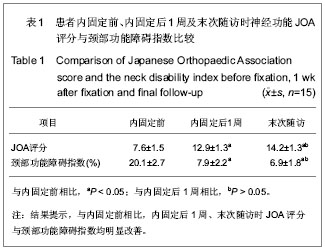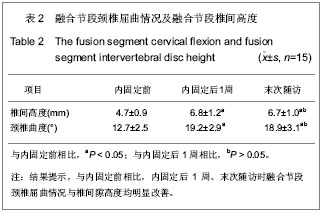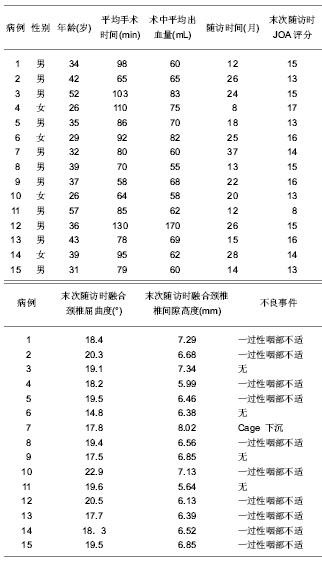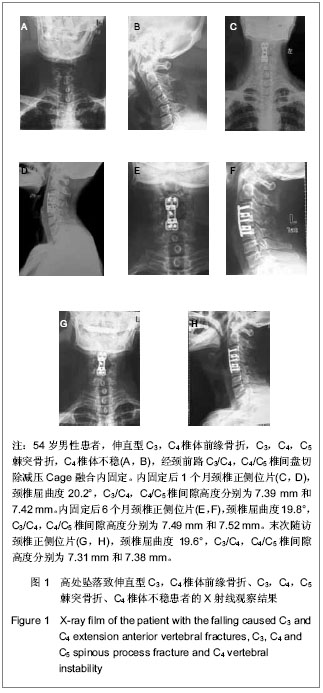| [1] 石美鑫,张延龄.现代外科学[M].复旦大学出版社,2002: 1638- 1639.
[2] 陈应东,龙厚清,张炳志,等.两种颈椎前路减压重建术治疗两节段颈椎病的疗效比较[J].中国临床解剖学,2010,28(6):698-670.
[3] Semantic D,Shen FH,Matthews DK,et al.Comparision of allograft to autograft in multilevel anterior cervical discectomy and fusion with rigid plate fixation. Spine. 2008;3(2):451.
[4] Vernon H,Mior S. The neck disability index:a study of reliability and validity. Manipulative Physiol Ther. 1991; 14(7):409-415.
[5] Caspar W,Geisler FH,Pitzen T,et al. Anterior cervical plate stabilization in one - and two -level degenerative disease:overtreatment or benefit. Spinal Disord. 2008; 11(1):1-3.
[6] 吴毅华. 颈椎前路减压加植骨融合与复合钛板置入内固定治疗脊髓型颈椎病的Meta分析:安全和有效吗?[J].中国组织工程研究与临床康复,2009,13(35):6827-6830.
[7] Anderson DG,Albert TJ. Bone grafting,implants,and plating options for anterior cervical fusions. Orthop Clin North Am. 2002;33(2):317-328.
[8] Lim TH,Kwon H,Jeon CH,et al. Effect of endplate conditions and bone mineral density on the compressive strength of the graft-endplate interface in anterior cervical spine fusion. Spine. 2001;26(8):951-956.
[9] Emery SE,Fisher JR,Bohlman HH. Three-level anterior cervical discectomy and fusion:radiographic and clinical results. Spine. 1997;22(22):2622-2625.
[10] 胥少汀,葛宝丰,徐印坎. 实用骨科学[M]. 北京:人民卫生出版社,2005:1535-1535.
[11] 王清,钟德君,王高举. 颈椎管狭窄伴无骨折脱位型脊髓损伤的MRI表现及手术治疗[J].中国脊柱脊髓,2009,12(9):354-356.
[12] 邱贵兴,戴尅戎. 骨科手术学[M]. 北京:人民卫生出版社,2005: 377-429.
[13] 李晶,盖景颖,卢畅. 颈椎前路钢板螺钉内固定置入系统的理论研究及其临床应用[J].中国组织工程研究与临床康复,2009, 13(30): 5931-5934.
[14] Ahn JS,Lee JK,Yang JY,et al. Chang of the lordosis on cervical spine after anterior interbody fusion with autogenous iliac strut bone graft. Korean Spine Surg. 2001;8(6):468-474.
[15] Hacker RJ, Cauthen JC. Prospective randomized multicenter clinical evaluation of anterior cervical fusion cage. Spine. 2005;20(12): 2646-2655.
[16] Kabir SM,Alabi J,Rezajooi K,et al. Anterior cervical corpectomy:review and comparison of results using titanium mesh cages and carbon fibre reinforced polymer cages. Br J Neurosurg. 2010;24(5):542-546.
[17] Barsa P, Suchomel P. Factors affecting sagittal malalignment due to cage subsidence in standalone cage assisted anterior cervical fusion. Eur Spine. 2007;16(31): 1395-1400.??
[18] 田伟.颈椎融合与非融合手术对相邻节段退变的影响[J].中国脊柱脊髓,2011,21(1):5-6.
[19] Elsawaf A,Mastronardi L,Roperto R,et al. Effect of cervical dynamics on adjacent segment degeneration after anterior cervical fusion with cages. Neurasurg Rev. 2009;32(2): 215-224.
[20] Kolstad F, Nygaard QP. Segmental motion adjacent to anterior cervical arthrodesis a prospective study. Spine. 2006; 5(6): 512-517.
[21] Tumialan LM,Pan J,Bodts GE,et al. The safety and efficacy of anterior cervical discectomy and fusion with polyetheretherketone spacer and recombinant human bone morphogenetic protein-2:a review of 200 patients.J Neurosurg Spine. 2008;8(6):529-535.
[22] Jawahar A,Cavanaugh DA,Kerr EJ,et al. Total disc arthroplasty does not affect the incidence of adjacent segment degeneration in cervical spine:results of 93 patients in three prospective randomized clinical trials. Spine J. 2010; 10(12): 1043-1048.
[23] 何达,韩骁,陶剑锋,等.颈椎人工间盘置换与颈椎内固定置入对相邻节段退变的生物力学影响[J].中国组织工程研究与临床康复, 2008,12(22):4229-4232.
[24] 孙宇. 颈椎前路融合术后相邻节段退变是自然进程还是术后结果[J].中国脊柱脊髓,2011,21(1):3-4.
[25] 朱庆三,尹飞. 如何看待颈椎前路融合术后相邻节段退变[J].中国脊柱脊髓,2011,21(1):4-5.
[26] 阮狄克. 颈椎融合加速相邻节段退变:真实还是虚构[J].中国脊柱脊髓,2011,21(1):6-7.
[27] Arregui R, Aso J, Martinez-Quinones JV, et al. Cervical interbody fusion system. Preliminary retrospective study in 104 cases (120 implants). Neurocirugia. 2011;22(6):542-553.
[28] Brodke DS,Klimo PJ,Bachus KN, et al. Anterior cervical fixation:analysis of load -sharing and stability with use of static and dynamic plates. J Bone Joint Surg Am. 2011;88(7): 1566-1573.
[29] Burkus JK,Haid RW,Traynelis VC,et al. Long-term clinical and radiographic outcomes of cervical disc replacement with the Prestige disc:results from a prospective randomized controlled clinical trial. Neurosurg Spine. 2010;13(3):308-318.
[30] 叶勇军,王少波,吴东保,等.颈前路单纯Cage与钉板固定融合术治疗颈椎病临床研究[J].中国矫形外科杂志,2010,18(15): 1299-1231. |



